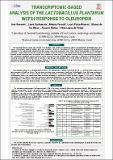Por favor, use este identificador para citar o enlazar a este item:
http://hdl.handle.net/10261/172029COMPARTIR / EXPORTAR:
 SHARE
BASE SHARE
BASE
|
|
| Visualizar otros formatos: MARC | Dublin Core | RDF | ORE | MODS | METS | DIDL | DATACITE | |

| Campo DC | Valor | Lengua/Idioma |
|---|---|---|
| dc.contributor.author | Reverón, Inés | - |
| dc.contributor.author | Santamaría, Laura | - |
| dc.contributor.author | Franch, Mónica | - |
| dc.contributor.author | Plaza-Vinuesa, Laura | - |
| dc.contributor.author | Rivas, Blanca de las | - |
| dc.contributor.author | Muñoz, Rosario | - |
| dc.date.accessioned | 2018-11-08T13:17:59Z | - |
| dc.date.available | 2018-11-08T13:17:59Z | - |
| dc.date.issued | 2017 | - |
| dc.identifier.citation | BioMicroWorld 2017 | - |
| dc.identifier.uri | http://hdl.handle.net/10261/172029 | - |
| dc.description | Póster presentado a la VII International Conference on Environmental Industrial and Applied Microbiology, celebrada en Madrid (España) del 18 al 20 de octubre de 2017. | - |
| dc.description.abstract | Oleuropein is the main phenolic component of olive leaves, seed, pulp and peel of unripe olive fruits and is present in higher amounts in oils obtained from green olives. This compound confers natural resistance to Olea europeae against both gram positive and gram negative bacteria. On account of its anti-microbial activity oleuropein might play an important role to select the microbiota that colonizes the olive epidermis which is crucial for the quality of fermented table olives. Therefore it is important to increase knowledge on the oleuropein tolerance mechanisms of the olive microbiota. To this goal we have investigated how oleuropein affects the expression profile of Lactobacillus plantarum at genome scale since this microorganism colonizes the olive epidermis and plays an important role in the fermentation of olives. Whole-transcriptome analysis was based on customized microarray profiles. Differentially expressed genes (fold-changes { 2 (p < 0.05)) were used to perform a functional analysis by using the DAVID bioinformatics tool. The transcriptomic response revealed differential expression of genes involved in the transport and metabolism of several carbohydrates. Other set of genes whose expression was affected by the presence of oleuropein was that dedicated to the biosynthesis of fatty acids. In addition genes involved in the biosynthesis of membrane and cell wall components were also differentially transcribed respect to controls. Stress responses, including a specific oxidative stress response, were revealed by the transcriptomic datasets indicating the antimicrobial properties of this phenolic compound. | - |
| dc.relation.isversionof | Publisher's version | - |
| dc.rights | openAccess | - |
| dc.subject | Oleuropein | - |
| dc.subject | Transcriptomics | - |
| dc.title | Transcriptomic-based analysis of the Lactobacillus plantarum WCFS1 response to oleuropein | - |
| dc.type | póster de congreso | - |
| dc.date.updated | 2018-11-08T13:17:59Z | - |
| dc.description.version | Peer Reviewed | - |
| dc.language.rfc3066 | eng | - |
| dc.relation.csic | Sí | - |
| dc.type.coar | http://purl.org/coar/resource_type/c_6670 | es_ES |
| item.fulltext | With Fulltext | - |
| item.openairecristype | http://purl.org/coar/resource_type/c_18cf | - |
| item.cerifentitytype | Publications | - |
| item.grantfulltext | open | - |
| item.openairetype | póster de congreso | - |
| Aparece en las colecciones: | (ICTAN) Comunicaciones congresos (CNB) Comunicaciones congresos | |
Ficheros en este ítem:
| Fichero | Descripción | Tamaño | Formato | |
|---|---|---|---|---|
| Ponen18based.pdf | 196,84 kB | Adobe PDF |  Visualizar/Abrir |
CORE Recommender
Page view(s)
292
checked on 23-abr-2024
Download(s)
110
checked on 23-abr-2024
Google ScholarTM
Check
NOTA: Los ítems de Digital.CSIC están protegidos por copyright, con todos los derechos reservados, a menos que se indique lo contrario.
